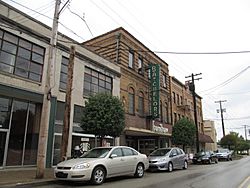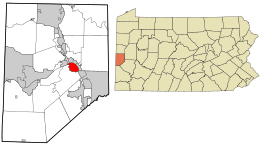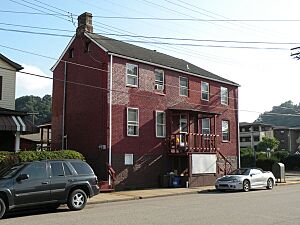Monaca, Pennsylvania facts for kids
Quick facts for kids
Monaca, Pennsylvania
|
||
|---|---|---|

Downtown Monaca
|
||
|
||
| Motto(s):
"Leading the Way in Beaver County"
|
||

Location in Beaver County, Pennsylvania (left) and of Beaver County in Pennsylvania (right)
|
||
| Country | United States | |
| State | Pennsylvania | |
| County | Beaver | |
| Settled | 1787 | |
| Incorporated | 1840 | |
| Named for | Monacatootha | |
| Government | ||
| • Type | Mayor-council | |
| Area | ||
| • Total | 2.38 sq mi (6.17 km2) | |
| • Land | 2.03 sq mi (5.25 km2) | |
| • Water | 0.35 sq mi (0.92 km2) | |
| Elevation | 938 ft (286 m) | |
| Population
(2020)
|
||
| • Total | 5,625 | |
| • Density | 2,775.04/sq mi (1,071.43/km2) | |
| Time zone | UTC-5 (Eastern (EST)) | |
| • Summer (DST) | UTC-4 (EDT) | |
| Zip Code |
15061
|
|
| Area code(s) | 724 | |
| FIPS code | 42-50320 | |
Monaca (pronounced mi-NAK-uh) is a small town, called a borough, in Beaver County, Pennsylvania, USA. It's right next to the Ohio River. In 2020, about 5,625 people lived there. Monaca is about 25 miles (40 km) northwest of Pittsburgh and is part of the larger Pittsburgh area.
It was first named Phillipsburg in 1840. Later, its name changed to Monaca. This was to honor a Native American leader named Monacatootha from the Oneida people. Monaca is also known for having a lot of fire clay and a glass factory called Stölzle Glass.
Contents
Discovering Monaca's Past
Early Beginnings
Monaca has a long history, going back to the 1700s. The land was first given by Pennsylvania in 1787 to Ephraim Blaine. He was a colonel who served in the Continental Army during the American Revolutionary War. This land was called "Appetite."
In 1813, a Polish nobleman named Francis Helvidi bought the land. He tried to raise sheep there, but it didn't work out. In 1821, the land was sold to George Rapp, a leader of the Harmony Society.
In 1822, Stephen Phillips and John Graham bought the property. They started large boat yards on the Ohio River. The town was first named Phillipsburg after Stephen Phillips. They built many steamboats, including one that carried the Harmonites to their new home in Old Economy Village.
New Communities and Changes
In 1832, Phillips and Graham sold the land to a group that had left the Harmony Society. This group was led by Bernhard Müller, also known as Count de Leon. These German immigrants formed a religious community called the New Philadelphian Congregation. They built a church, a hotel, and other buildings. They even renamed the town "Löwenburg," meaning "Lion City."
Müller's group sold their land in 1833, but some members stayed in Monaca. Later, in the 1840s, another religious leader named William Keil came to the area. Some former members of the New Philadelphia Society followed him. His group later moved away to start new towns like Bethel, Missouri and Aurora, Oregon.
In 1840, the area officially became the "Borough of Phillipsburg." The first mayor was Frederick Charles Speyerer.
Mid-1800s to Late 1800s
In 1848, Edward Acker started a "Watercure Sanatorium" in Phillipsburg. This was a place where people used water for healing. It was the first hospital in Beaver County, Pennsylvania. When the town's first post office opened in 1856, it was named "Water Cure."
In 1865, Reverend William G. Taylor bought the Sanatorium buildings. He turned them into a Soldiers' Orphans Home for children whose parents had died in the war. This home had dorms, a dining room, a school, and a playground. It sadly burned down in 1876. You can find a historical marker about this near Fourth Street and Route 18.
Thiel College was founded in Monaca in 1866. Five years later, it moved to Greenville, Pennsylvania. A historical marker on Fourth Street tells its story.
In 1892, the town's name officially changed from Phillipsburg to Monaca. This was to honor the Native American leader Monacatootha. He was an Oneida warrior chief. Monacatootha was a good friend to the English and worked against the French. He even met with George Washington in Logstown.
Monaca in Modern Times
Over the years, Monaca has been home to many factories. They made things like enameled porcelain, glass, tiles, and steel products. Today, Stölzle Glass USA, which used to be Phoenix Glass, is still in Monaca.
In 2003, Monaca was involved in a health concern. An illness spread to many people in Ohio and Pennsylvania from a restaurant in town.
In 2012, Royal Dutch Shell announced plans to build a large chemical complex near Monaca. This complex would use natural gas from the Marcellus Formation to make ethylene. This would be the first plant of its kind in the northeastern U.S. In 2016, Shell Chemical Appalachia decided to build the Shell Pennsylvania Petrochemicals Complex near Monaca.
Monaca's Location and Surroundings
Monaca is located at 40°41′2″N 80°16′37″W, on the south side of the Ohio River.
The United States Census Bureau says Monaca covers about 2.38 square miles (6.2 square kilometers). Most of this is land, but about 0.35 square miles (0.9 square kilometers) is water.
Nearby Areas and Bridges
Monaca shares a land border only with Center Township to its south and west. Across the Ohio River, Monaca is next to several other towns. These include Beaver, Bridgewater, Rochester, East Rochester, Freedom, and Conway.
Three bridges connect Monaca to other places across the Ohio River:
- The Rochester–Monaca Bridge carries Pennsylvania Route 18 into Rochester.
- The Monaca–East Rochester Bridge carries Pennsylvania Route 51 into East Rochester.
- The Beaver Bridge carries train tracks owned by CSX Transportation into Bridgewater.
Monaca's Population and People
| Historical population | |||
|---|---|---|---|
| Census | Pop. | %± | |
| 1840 | 325 | — | |
| 1850 | 473 | 45.5% | |
| 1860 | 434 | −8.2% | |
| 1870 | 554 | 27.6% | |
| 1880 | 458 | −17.3% | |
| 1890 | 1,494 | 226.2% | |
| 1900 | 2,008 | 34.4% | |
| 1910 | 3,376 | 68.1% | |
| 1920 | 3,838 | 13.7% | |
| 1930 | 4,641 | 20.9% | |
| 1940 | 7,061 | 52.1% | |
| 1950 | 7,415 | 5.0% | |
| 1960 | 8,394 | 13.2% | |
| 1970 | 7,486 | −10.8% | |
| 1980 | 7,661 | 2.3% | |
| 1990 | 6,739 | −12.0% | |
| 2000 | 6,286 | −6.7% | |
| 2010 | 5,737 | −8.7% | |
| 2020 | 5,625 | −2.0% | |
| 2021 (est.) | 5,542 | −3.4% | |
| Sources: | |||
According to the 2000 census, 6,286 people lived in Monaca. There were 2,709 households and 1,741 families. The population density was about 3,004 people per square mile (1,160 per square kilometer).
Most of the people in Monaca were White (97.1%). About 1.9% were African American, and 0.2% were Asian. About 0.6% of the population was Hispanic or Latino.
About 22% of the people were under 18 years old. The average age was 41 years. For every 100 females, there were about 87 males.
The average income for a household in Monaca was $33,706. For a family, it was $45,046. About 8.9% of the population lived below the poverty line. This included 16.7% of those under 18.
Since 2019, Monaca has seen some new growth. New businesses and jobs have brought more people to the area.
Education in Monaca
Children in Monaca attend schools in the Central Valley School District. This district was formed on July 1, 2009. It was created by combining the former Center Area School District and Monaca School District. This was Pennsylvania's first "voluntary" public school district merger. It took five years to complete.
The schools that serve Monaca are:
- Center Grange Primary School – for grades K–2
- Todd Lane Elementary School – for grades 3–5
- Central Valley Middle School – for grades 6–8
- Central Valley High School – for grades 9–12
Famous People from Monaca
Monaca has been home to several notable individuals, including:
- Brad Davis – a professional basketball player
- Mickey Davis – also a professional basketball player
- Ed DeChellis – the head coach for the Navy men's basketball team
- Dusty Drake – a country music artist
- Robert Foster – an NFL player for the Buffalo Bills
- Mike Manzo – a former chief of staff for a Pennsylvania House leader
- Teddy Yarosz – a boxer and former Middleweight Champion of the World
- Bill Zopf – an NBA player for the Milwaukee Bucks
- John Karcis – an NFL player and coach
See also
 In Spanish: Monaca para niños
In Spanish: Monaca para niños






